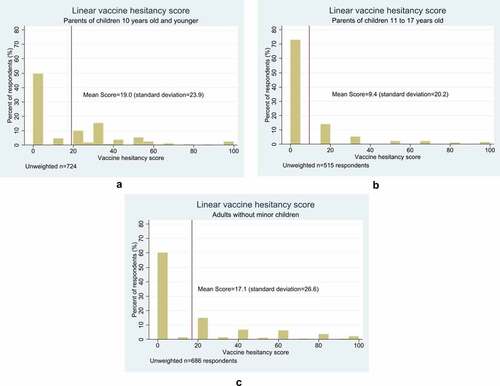Figures & data
Figure 1. A. Vaccine hesitancy among parents of young children 10 years old and younger, B. Vaccine hesitancy among parents of children 11 to 17 years old, and C. Vaccine hesitancy among parents without minor children

Table 1. Sociodemographic characteristics of the study population: weighted and unweighted
Table 2. The overall frequency and proportion of the study sample experienced with serious reactions to vaccines, genetic testing experience, and support for biobanks
Table 3. The overall frequency and proportion of participants’ responses to questions about the ethical and policy implications of vaccinomics
Table 4. Among people who agree/strongly agree with hypothetical scenarios, the frequency and proportion of participants’ concerns about the ethical and policy implications of vaccinomics: stratified by sociodemographic characteristics
Table 5. Among people who agree/strongly agree with hypothetical scenarios, the frequency and proportion of participants’ concerns about the ethical and policy implications of vaccinomics: stratified by experience with a serious vaccine reaction, vaccine hesitancy, and trust in public health authorities
Table 6. The overall frequency and proportion of participants’ responses to questions about vaccine prioritization, screening tests, and government spending to improve vaccine safety
Table 7. Among people who agree/strongly agree with hypothetical scenarios, the frequency and proportion of participants’ concerns related to vaccine prioritization and screening: stratified by experience with a serious vaccine reaction, vaccine hesitancy, and trust in public health authorities
Table 8. The overall frequency and proportion of how respondents prefer the U.S. government prioritize funding and implement vaccinomics
Table 9. Potential associations between opposition to vaccinomics and prioritization: expecting to feel angry if not prioritized for vaccination and strongly agreeing/agreeing that vaccination is an individual’s choice
Table 10. Potential associations between expected opposition to vaccinomics and prioritization: expecting to feel angry if not prioritized for vaccination and strongly agreeing/agreeing that vaccination is an individual’s choice
